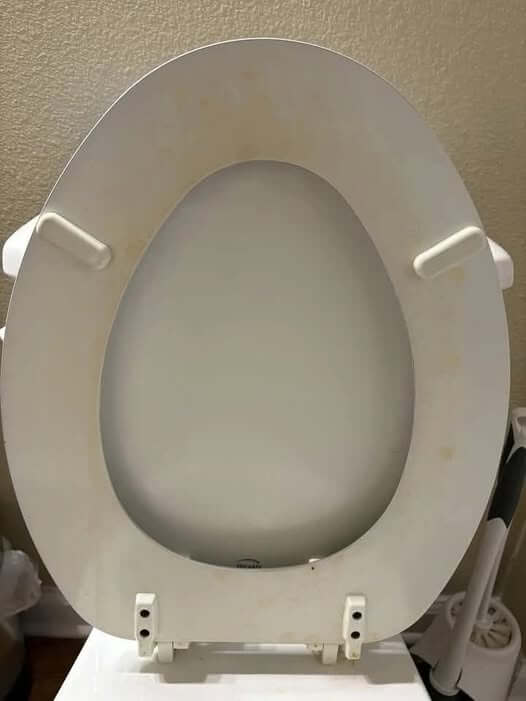Let’s be honest—few things ruin the look of a bathroom faster than a stubborn yellow stain on the toilet seat. Whether it’s caused by hard water, missed splashes, or buildup from infrequent deep cleaning, these unsightly marks seem impossible to get rid of. I used to do a quick scrub and hope for the best—until I had guests over who noticed everything. That was my wake-up call. Now, I’ve discovered cleaning techniques that truly work—not just for the bowl, but for the entire toilet area.
If you’re wondering how to eliminate deep-seated grime, fight persistent stains, and restore your toilet to a like-new state, this is the cleaning guide you need.
Why Toilet Stains Keep Coming Back
Understanding the cause of these stubborn marks helps you clean smarter, not harder. Here are the most common culprits:
- Hard water deposits: Calcium, lime, and iron from mineral-rich water often leave tough-to-remove residue.
- Urine stains: These can become embedded if not wiped away immediately.
- Mold and mildew: Bathrooms are humid environments—perfect for unwanted growth.
- Everyday grime: Sweat, dust, and oils build up faster than you think.
Knowing what you’re tackling helps you pick the right cleaning strategy.
Step-by-Step: How to Remove Yellow Stains from Your Toilet Seat and Hinges
White plastic toilet seats are notorious for collecting stains. But these proven methods can revive their original brightness.
Baking Soda + Vinegar Paste
This all-natural combo works wonders. Mix baking soda with just enough white vinegar to form a paste. Apply it to the stained areas and let it sit for 10–15 minutes. Use an old toothbrush or sponge to scrub, then wipe clean. This is especially effective for urine stains and general discoloration.
Magic Eraser for Instant Results
Once skeptical, I’ve now fully embraced the Magic Eraser. Whether you go with the name brand or a budget version, it can completely lift stubborn stains with minimal effort. A few swipes across the surface often removes what traditional cleaning couldn’t.
Hydrogen Peroxide for Deep-Set Stains
Soak paper towels in hydrogen peroxide and lay them over the stained area. Let it sit for about an hour before removing and wiping clean. It gently bleaches without damaging plastic. Pro tip: Never mix this with vinegar—rinse thoroughly between treatments.
How to Remove Rust and Mineral Rings From the Toilet Bowl
The bowl tends to trap rust-colored stains and mineral buildup. These strategies will help you scrub it clean without scratching the porcelain.
Pumice Stone (Use Carefully!)
Wet the pumice stone before use and gently rub it against the mineral ring. If you hear any scratching, stop immediately. Used correctly, it’s a great tool for breaking down limescale without damaging the toilet.
Vinegar and Baking Soda Flush
Pour a cup of vinegar directly into the bowl and sprinkle in some baking soda. Let the fizzing reaction do the heavy lifting for 15–30 minutes, then scrub with a toilet brush and flush.
Borax Powder Soak
Sprinkle borax generously around the bowl, especially where stains are present. Let it sit overnight, then scrub in the morning. It’s old-school, but incredibly effective—your grandmother’s secret weapon still holds up.
Bleach Tablets—Use With Caution
Bleach is powerful but potentially damaging over time. If you use toilet tank tablets, make sure they’re safe for plumbing and avoid combining bleach with vinegar or ammonia. Always follow label instructions carefully.
How to Deep Clean the Toilet Exterior—Base, Tank, and Buttons
Most people forget the outside of the toilet, which collects dust, hair, and hidden germs.
All-Purpose Spray and Microfiber Cloth
Spray the entire exterior—tank, handle, seat edges, and base—with a quality disinfectant or all-purpose cleaner. Wipe down with a microfiber cloth for a streak-free finish. Don’t forget the wall behind the toilet—splashes can reach there too.
Toothbrush for Hinges and Crevices
To reach the gross stuff around the hinges, bolts, and seat mounts, use an old toothbrush. These tight spaces are prime locations for grime buildup.
Clean Around the Base Thoroughly
Start with a duster to remove loose hair and debris. Then follow up with a disinfectant spray and rag. You’ll be shocked at how much gunk collects around the base—this is often the dirtiest spot in the whole bathroom.
Extra Toilet Cleaning Tips You’ll Be Glad You Knew
- Toilet brush odor: Add a little hydrogen peroxide or bleach to the holder every so often to keep smells at bay.
- Can’t remove a stain? Consider replacing the toilet seat—it’s affordable and might save you hours of scrubbing.
- Stay on schedule: I clean my toilet every Sunday. It’s not glamorous, but it’s a small habit that saves future headaches.
The Bottom Line: Clean Toilet, Clear Mind
No one brags about scrubbing a toilet, but the payoff is real. A sparkling clean bathroom sends the message that you’re on top of your game. It boosts home hygiene, reduces odors, and prevents long-term staining.
From yellow toilet seat rings to rusty bowl stains, consistent maintenance is the real secret. Use affordable, effective tools like baking soda, hydrogen peroxide, and the occasional Magic Eraser—and clean with purpose.
Whether you’re prepping for guests or just want your home to feel fresh and welcoming, a gleaming toilet is an underrated win. And if you pair your scrubbing session with a podcast or favorite playlist? Even better.
